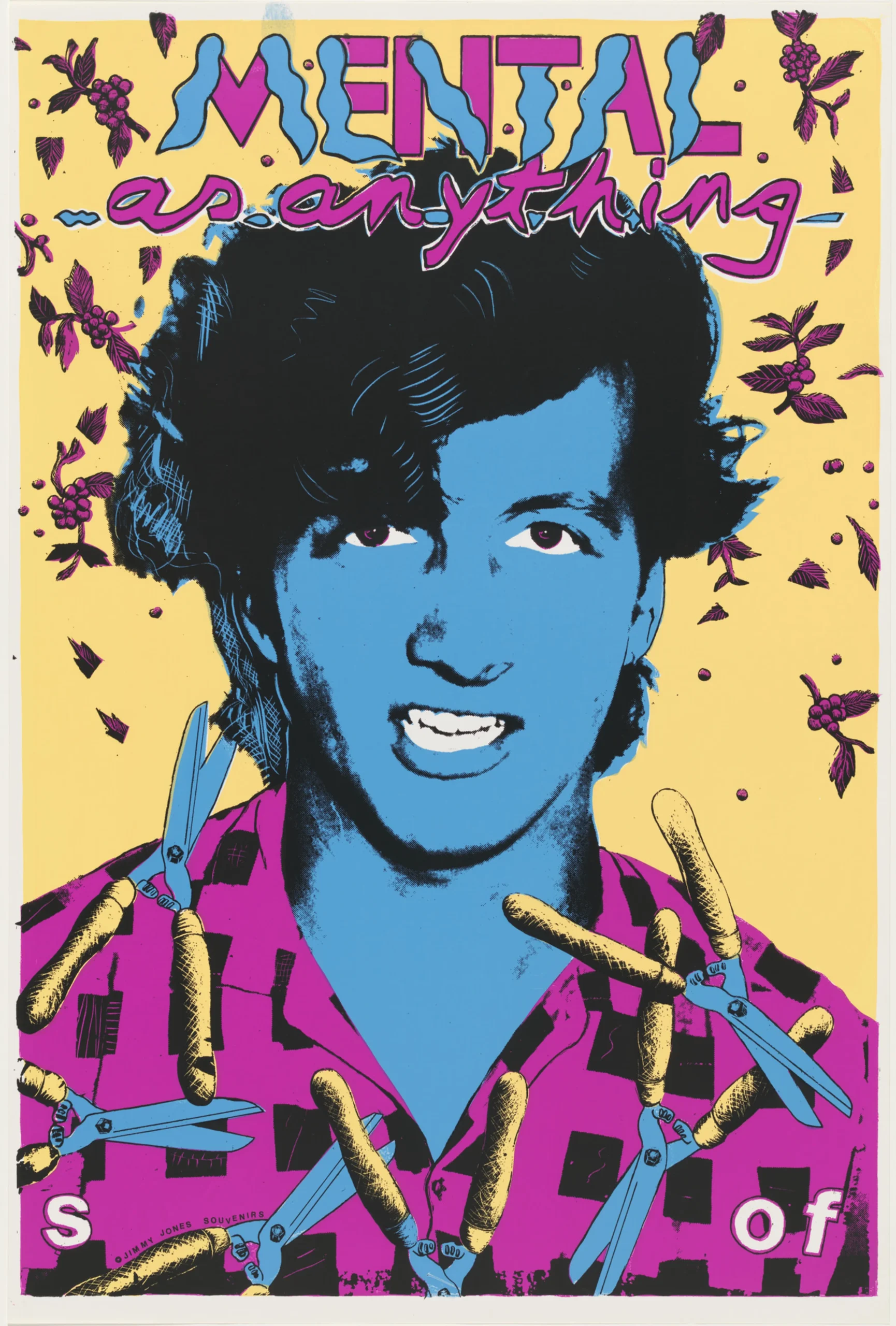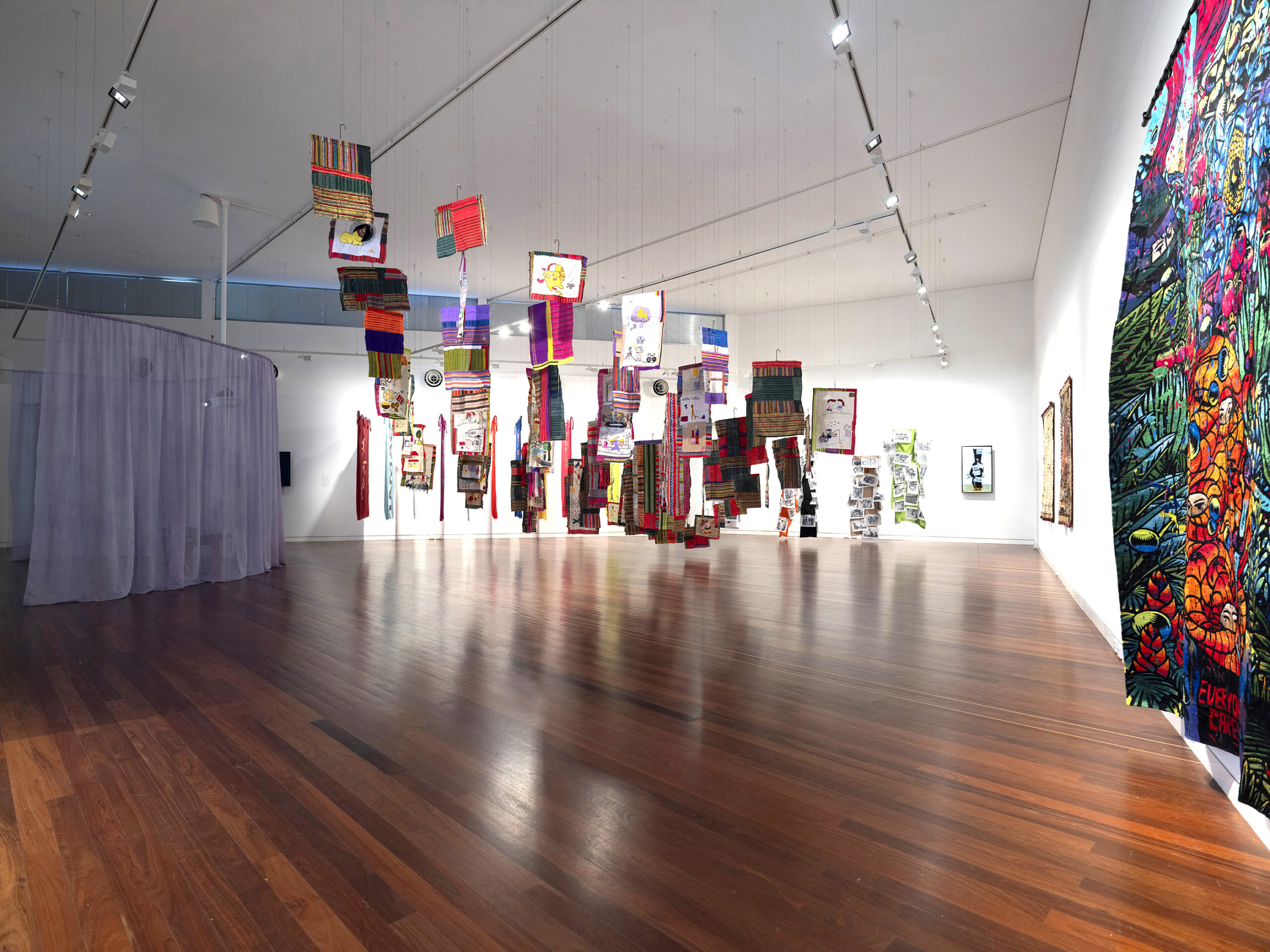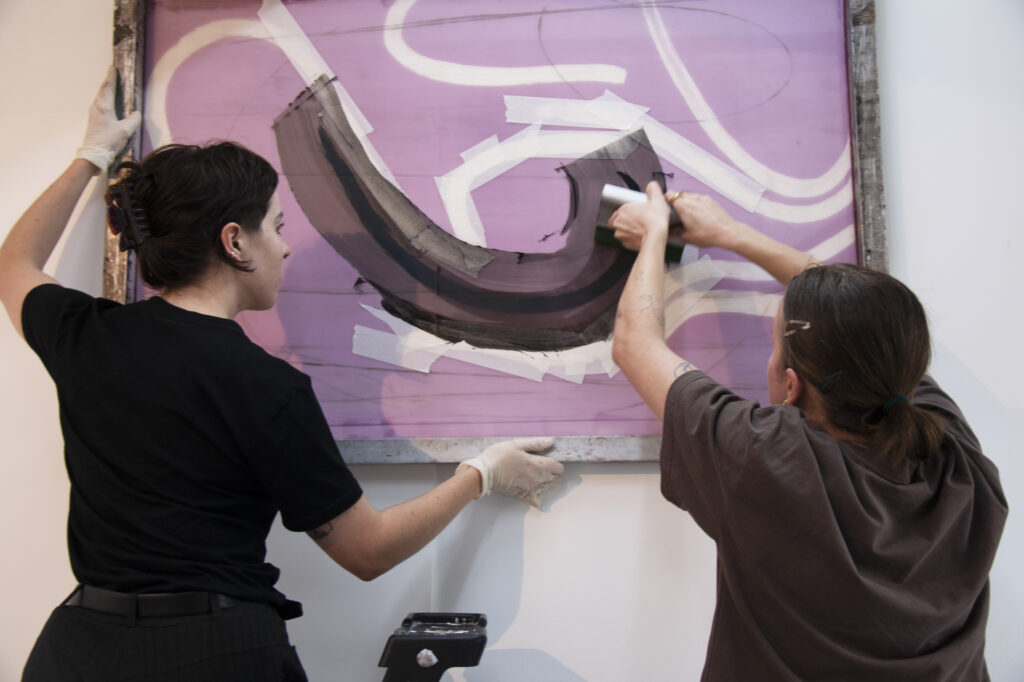
mouth open, mouth closed at Onespace is Stella Haycock’s commercial debut, continuing their exploration of typographic installations. The solo exhibition further resolves their recent Honours work, a kind of breathing room (2023), to consider the gallery context as a fluid and dimensional surface for screen printing. In mouth open, mouth closed, the artist traces inky lines across the gallery’s walls, ceiling, and floor, punctuating the viewer’s perception of space.
I first encountered Haycock’s work in their graduate installation, which hung printmaking paper in Queensland College of Art and Design’s White Box Gallery and condensed abrupt and decisive forms across its cornered wall. This work could be seen from a single standpoint, read without pause as a complete gesture or ‘sentence.’ Onespace provides an alternative canvas to Haycock. The space’s slanted right-hand-wall and back-right-corner provide plenty of room for the artist’s forms to breathe, meander, and take hold. The artist’s previous work’s stark marks had the typographic intensity of ‘extra black’ font. By contrast, the forms in mouth open, mouth closed are refined to a rhythmic movement. Their curvature mirrors the artist’s body as it draws in and relinquishes air.
Haycock’s manoeuvres her six distinct letterforms across the gallery to create a series of phrases or couplings. The artist carefully resolved these marks through repetition (similar to the formation of a personal signature). This creative process is made clear in Haycock’s two video artworks, needle in a haystack (2024) and my original concerns (2024). They visualise Haycock’s impulse to write and rewrite her forms until they are fully ‘understood,’ like the repetitive tracing of letters in a child’s schoolbook. In turn, Haycock’s scribbling becomes a repetitious hum that permeates the gallery space.
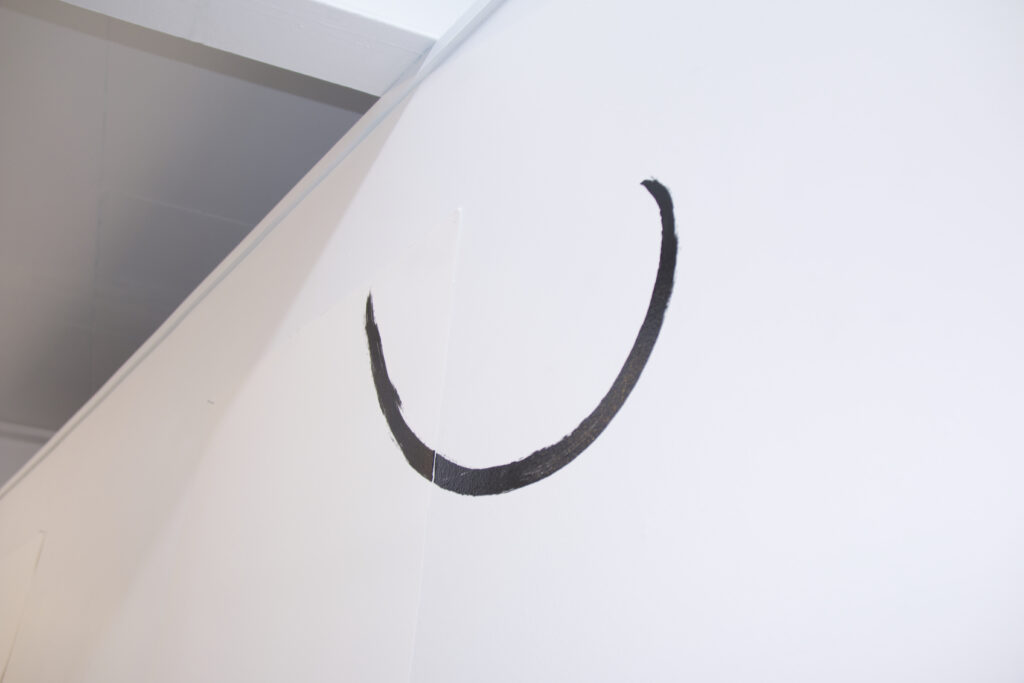
Haycock’s finalised forms are then painted on acetate and exposed to a silkscreen. Printing directly on the wall, and on evenly spaced hung paper, Haycock transfers the traditional two-dimensionality of screenprinting to the irregularities and multi-surfaces of an interior space. Walking through the gallery, there is a delight in stumbling across these errant forms: stuck to hidden crevices, support beams, and the gallery’s ceiling. In turn, I began to imagine Haycock’s own movement within the space, arms arched to reach the wall’s height, knee’s crouching and grip tightening as they pressed firmly with the ink-laden squeegee onto the gallery floor.
Georges Didi-Huberman uses the French word empreinte to convey the broad processes used to create ‘prints,’ ‘impressions,’ ‘marks,’ and ‘traces.’1 Interestingly, Didi-Huberman foregrounds the empreinte’s repetitive and procedural nature as also open to chance and uncertainty.2 The process of creating each impression is unique, as each imprint exists in a different location (dependent on material and texture of its surface) and because “each action, gesture [and] procedure” is individual to the impression’s creation.3 Similarly, Haycock’s six repeated forms are imprinted with their own distinctive imperfections and textures, reflecting their substrate (concrete floor, painted wall, and cotton paper), and the hand of the artist.
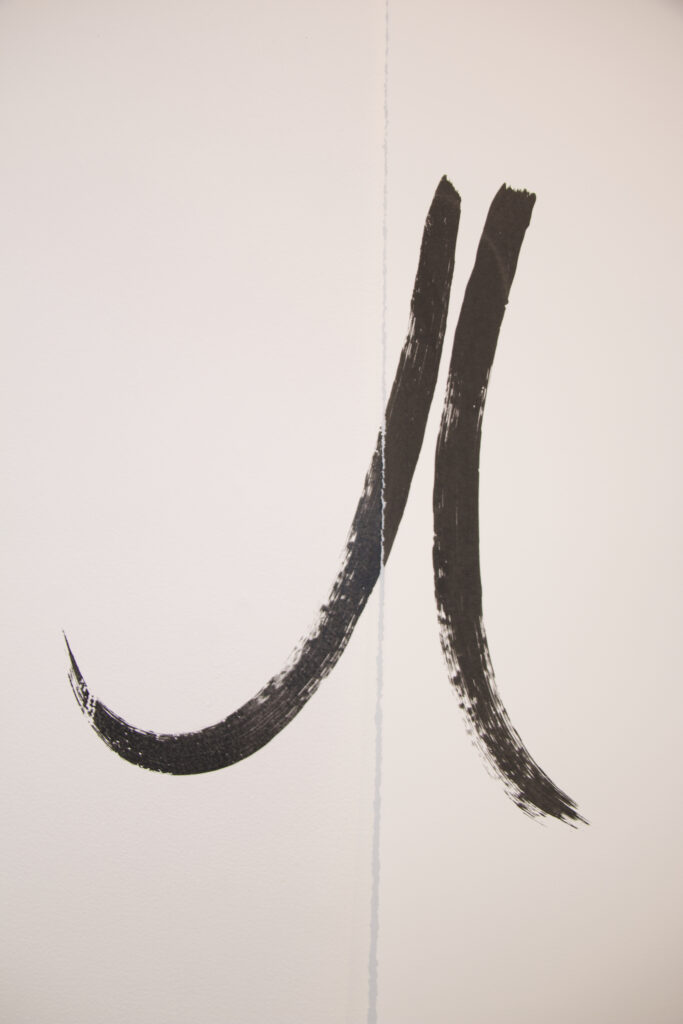
Looking closely, Haycock’s calligraphic marks lose their opaque blackness to reveal the fine grey lines of a brushstroke. Their edges are rough and speckled and it is difficult to tell whether this is the result of misprinting or the mark-making of their original exposed image. They become facsimiles of brushstrokes, betraying the expected flatness of printmaking for the textured surface and idiosyncrasies of the painter’s mark. As such, mouth open, mouth closed mirrors the distinctness of a handwritten message, its letters lifted from the page and scattered indistinguishably across the gallery.
Just as Haycock’s printmaking marks are painterly, their printmaking paper takes on a sculptural form. Each page is pinned by its top two corners, such that it lifts from the wall and curls in or out, like the printed marks. Haycock’s impressions are not positioned centrally on these pieces of paper. Instead, they straddle the edges of the paper and the wall so there are gaps and interruptions in their flow. Some pages are empty, including a sheet of paper cheekily folded into the gallery’s left corner.
Didi-Huberman queries if impressions “demonstrate the authenticity of presence (in direct physical contact) or a loss of uniqueness contingent on the possibility of [their] reproduction?”4 Haycock’s installation embodies this contradiction. The week of labour spent installing the exhibition’s temporal installation is juxtaposed with an editioned folio of the artist’s ‘letter’ prints, ready for collectors to purchase and take home. This second series, titled anachronistically assembled (2024), delineates the six coupled characters into separate artworks, each emulating an articulation of the mouth (i.e. baring teeth and making a puff of air). In conversation, Haycock describes their letterforms as existing without language, instead they correspond to the rhythm of the airways before sound escapes from the mouth. The artist’s letters link directly to their bodily motion, relinquishing the printed type’s implicit relationship with direct symbolic meaning. Thus, Haycock’s work playfully breaks down the printed medium’s conventions to contend with the nature of its unique physicality and concurrent reproducibility.
Onespace has given Haycock ample time and space for the repetition and refinement required to realise this work. Consequently, this site-specific installation has taken on the hallmarks of an artist residency, where an artist’s physical surroundings inspire and lead the trajectory of their final work. The gallery’s proclivity for printed, editioned, and otherwise more affordable art lends it to showcasing emerging talents like Haycock, (Renee Kire’s Any way, Shape or Form and Onespaces’ rightNOW series are other examples of this interest), alongside its stable of represented artists. It is refreshing to see a commercial gallery being used as a space of experimentation and to witness a key moment in Haycock’s artistic development. Like a gasp of air, mouth open, mouth closed provides Stella Haycock oxygen to spread out, ideate, and refine an alternative visual inflection, separated from the constraints of print and page.
- Didi-Huberman, “Opening up an anachronistic point of view (1997),” Perspectives on Contemporary Printmaking: Critical writing since 1986 (Manchester: Manchester University Press, 2018), 184. ↩︎
- Chari Larsson, Didi-Huberman and the Image (Manchester: Manchester University Press, 2020), 101. ↩︎
- Didi-Huberman, “Opening up an anachronistic point of view,” 185. ↩︎
- Didi-Huberman, “Opening up an anachronistic point of view,” 188. ↩︎
Kathleen O’Hagan is an emerging writer, artist and educator based in Meanjin, Brisbane.

